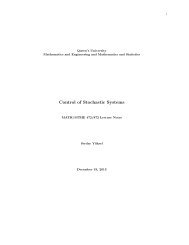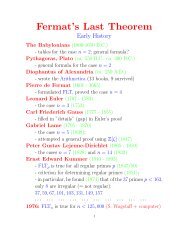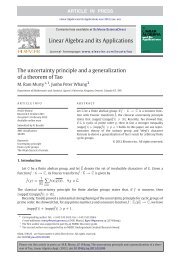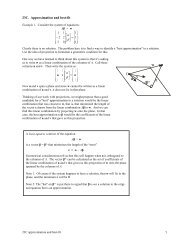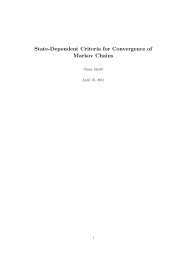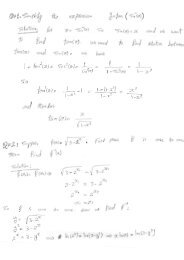Lecture 5: The Prasna and Mundaka Upanishads
Lecture 5: The Prasna and Mundaka Upanishads
Lecture 5: The Prasna and Mundaka Upanishads
Create successful ePaper yourself
Turn your PDF publications into a flip-book with our unique Google optimized e-Paper software.
Chapter 5<br />
<strong>Prasna</strong> <strong>and</strong> <strong>Mundaka</strong><br />
<strong>Upanishads</strong><br />
5.1 <strong>The</strong> <strong>Prasna</strong> Upanishad<br />
<strong>The</strong> word prasna means question in Sanskrit. <strong>The</strong> <strong>Prasna</strong> Upanishad is a series<br />
of six questions asked by students to the sage Pippalada. <strong>The</strong> opening verses<br />
are significant. When the students approached the sage for instruction, the<br />
sage said to them: “Live with me in this hermitage for one year, practicing<br />
self-control <strong>and</strong> austerity with faith (sraddha). <strong>The</strong>n ask me questions <strong>and</strong> if I<br />
can answer, I will try to answer.”<br />
Even the ability to ask intelligent questions requires mental <strong>and</strong> physical<br />
preparation. We cannot rush into them. After posing the question, we must<br />
also have the ability to receive the answer. <strong>The</strong>se abilities, according to the sage,<br />
can be acquired through self-control (brahmacharya) <strong>and</strong> austerity (tapas). <strong>The</strong><br />
word brahmacharya is often translated as chastity or continence, however, its<br />
precise meaning is revealed by breaking the word into its component parts:<br />
brahma <strong>and</strong> acharya. <strong>The</strong> first word indicates the universal awareness <strong>and</strong> is<br />
one we have met before. <strong>The</strong> second, is derived from achara meaning conduct,<br />
or more precisely, a regulated way of living guided by self-discipline. Thus etymologically,<br />
brahmacharya means regulated self-discipline to realise Brahman,<br />
or universal awareness. However, there is more to the meaning of this word.<br />
<strong>The</strong> fundamental teaching of the <strong>Upanishads</strong> is that the human being is not<br />
separate from the universe, but only a part of it, just as a wave is a part of
40 <strong>Prasna</strong> <strong>and</strong> <strong>Mundaka</strong> <strong>Upanishads</strong><br />
the ocean. Aurobindo elaborates 1 as follows. “An infinite energy ... pervades<br />
the world, pours itself into every name <strong>and</strong> form, <strong>and</strong> the clod, the plant, the<br />
insect, the animal, the man are, in their phenomenal existence, merely more or<br />
less efficient adharas 2 of this energy. We are each of us a dynamo into which<br />
waves of that energy have been generated <strong>and</strong> stored, <strong>and</strong> are being perpetually<br />
conserved, used up <strong>and</strong> replenished. <strong>The</strong> same force which moves in the star<br />
<strong>and</strong> the planet, moves in us, <strong>and</strong> all our thought <strong>and</strong> action are merely its play<br />
<strong>and</strong> born of the complexity of its functionings. <strong>The</strong>re are processes by which<br />
man can increase his capacity as an adhara. <strong>The</strong>re are processes by which he<br />
can clear of obstructions the channel of communication between himself <strong>and</strong> the<br />
universal energy <strong>and</strong> bring greater <strong>and</strong> greater stores of it pouring into his soul<br />
<strong>and</strong> brain <strong>and</strong> body.”<br />
Thus, the essential principle of brahmacharya is the elimination of distractions<br />
<strong>and</strong> the focussing of energies for a higher purpose. We see this even in<br />
modern life. We cannot spend all our time watching television <strong>and</strong> at the same<br />
time expect to prove a great mathematical theorem, or compose a literary epic.<br />
Proficiency in anything requires self-discipline <strong>and</strong> regular practice. This is the<br />
message of the sage in the opening verse of the Upanishad.<br />
<strong>The</strong> first question is “How did creation come into being?” <strong>The</strong> sage Pippalada<br />
answers, “<strong>The</strong> Father of Creation (prajapati) desired offspring <strong>and</strong> performed<br />
austerity (tapas) out of which life (prana), or universal energy, <strong>and</strong> matter (rayi)<br />
have come. It thought, ‘<strong>The</strong> combination of these two will produce creatures in<br />
many ways.’ Thus everything we see is the combination of matter (rayi) <strong>and</strong><br />
energy (prana). <strong>The</strong> sun is life, matter is the moon. Matter is all this, whatever<br />
is formed <strong>and</strong> formless. <strong>The</strong>refore, whatever is formed is matter. <strong>The</strong> rising sun<br />
pervades the east <strong>and</strong> fills with energy all the beings that are there. Likewise,<br />
when the sun’s rays fall on the south, the west, the north, the zenith, the nadir,<br />
<strong>and</strong> the intermediate regions, all beings there are energised. Prana is the soul<br />
of the universe; it is the light that animates <strong>and</strong> illumines everything.”<br />
<strong>The</strong>n another student approached the teacher <strong>and</strong> asked the second question.<br />
“What are the energies that sustain the body?” To him, the sage replied, “Ether,<br />
Air, Fire, Water <strong>and</strong> Earth, as well as Speech, Mind, Sight <strong>and</strong> Hearing sustain<br />
this body. But all of these are supported by prana, the Life Principle. As fire,<br />
Prana burns; as the sun, he shines. As cloud, he rains. As Indra, he rules the<br />
gods; as wind, he blows. As the moon, he nourishes all. He is all that is visible<br />
<strong>and</strong> all that is invisible. Prana moves in the womb. As breath, it lives in the<br />
body. As fire, it transports energy to all the organs. Prana protects us as a<br />
mother protects her children.”<br />
1 Aurobindo, Complete Works, Vol. 3, p. 332.<br />
2 vehicles, vessels or supports
5.1 <strong>The</strong> <strong>Prasna</strong> Upanishad 41<br />
Ether is to be interpreted as space. <strong>The</strong> message is that the manifestation<br />
of life is everywhere, in the sun, in the clouds, in the wind. <strong>The</strong> moon symbolises<br />
matter, as signalled in the earlier verse, <strong>and</strong> so it is that matter, or more<br />
precisely, food, ‘nourishes all.’ Now the third student approaches the teacher<br />
<strong>and</strong> asks, “How did prana come about? How did it enter the body? How does<br />
it distribute itself there? How does it go out of the body? How does it hold<br />
together the body, mind <strong>and</strong> the sense organs?”<br />
This student is clever. He managed to ask several questions <strong>and</strong> compress<br />
them into one. We may assume that this is one of the fruits of his year-long<br />
austerity. <strong>The</strong> sage responds by saying, “You ask very difficult questions, but<br />
since you are a sincere seeker of Truth, I will try to answer. Prana is born of the<br />
atman but like a man <strong>and</strong> his shadow, the atman <strong>and</strong> prana are inseparable. It<br />
enters the body by the action of Mind or manas. Prana itself may be divided<br />
into five parts, prana, apana, vyana, udana <strong>and</strong> samana. Prana, the first, dwells<br />
in the upper body, in the eye, ear, mouth <strong>and</strong> nose. <strong>The</strong> apana dwells in the<br />
lower, in the excretory organs, samana dwells in the middle, in the abdomen.<br />
In the heart are 101 arteries, from each of which emanate 100 smaller arteries.<br />
From each of these emanate 72,000 branch arteries. Vyana dwells in them. In<br />
the nerve located in the center of the spine dwells udana, leads the virtuous<br />
man upward, the sinful man downward <strong>and</strong> one who is both into the world of<br />
beings.”<br />
In explaining these verses, Aurobindo writes 3 , “Prana manifests itself in<br />
five distinct vital powers, to which the names, Prana, Samana, Vyana, Apana<br />
<strong>and</strong> Udana have been given by the ancient writers. Prana, the vital force par<br />
excellence has its seat in the upper part of the body <strong>and</strong> conducts all mental<br />
operations, the indrawing <strong>and</strong> outdrawing of breath <strong>and</strong> induction of food.<br />
Samana, seated centrally in the body, balances, equalises <strong>and</strong> harmonises the<br />
vital operations <strong>and</strong> is the agent for the assimilation of food. Vyana pervades<br />
the whole body; on it depends the circulation of the blood <strong>and</strong> distribution of<br />
the essential part of the food eaten <strong>and</strong> digested throughout the body. Apana,<br />
situated in the lower part of the trunk, presides over the lower functions, especially<br />
over the emission of such parts of the food as are rejected by the body<br />
<strong>and</strong> over procreation; it is intimately connected with the processes of decay <strong>and</strong><br />
death. Udana is the vital power which connects bodily life with the spiritual<br />
element in man.” Thus, the five-fold prana controls the nervous energies of the<br />
human being.<br />
<strong>The</strong>n the fourth student approaches the teacher <strong>and</strong> asks, “When a man’s<br />
body is asleep, who is it within that sleeps? Who is awake, <strong>and</strong> who is it that<br />
sees the dreams?”<br />
3 See Aurobindo, Collected Works, Vol. 27, p. 221.
42 <strong>Prasna</strong> <strong>and</strong> <strong>Mundaka</strong> <strong>Upanishads</strong><br />
<strong>The</strong> teacher replies, “When a man sleeps, the sensory organs are drawn in.<br />
However, the pranas, the fires of life, sleep not. <strong>The</strong> mind is led nearer to the<br />
atman. In the dream state, the mind revives its past impressions. Whatever it<br />
has seen, it sees again. Whatever it has heard, it hears again. Whatever it has<br />
enjoyed in various places, it enjoys again. What has been seen <strong>and</strong> not seen,<br />
heard <strong>and</strong> not heard, enjoyed <strong>and</strong> not enjoyed, both the real <strong>and</strong> unreal, the<br />
mind sees all <strong>and</strong> becomes the all.”<br />
This passage represents an early attempt at dream analysis. At the same<br />
time, it makes the vital point that while we sleep, the digestion, assimilation,<br />
circulation of blood <strong>and</strong> other bodily functions continue, so the prana never<br />
sleeps. <strong>The</strong> last line, ‘the mind becomes the all’ is significant. In the dream<br />
state, we forget that we are all the characters of the dream. Modern in-depth<br />
psychology has shown that all the dream symbols are aspects of our own mind,<br />
whether individual or collective. However, the sage does not seem to attach<br />
too much importance to these dream symbols. His main point is to draw our<br />
attention to the prana which never sleeps.<br />
<strong>The</strong> sage continues, “When the mind is overpowered by deep sleep, it dreams<br />
no more. As the birds fly to the tree for rest, even so do all these things fly to<br />
the atman for rest. Earth <strong>and</strong> its subtle essence, water <strong>and</strong> its subtle essence,<br />
fire <strong>and</strong> its subtle essence, air <strong>and</strong> its subtle essence, ether <strong>and</strong> its subtle essence,<br />
the eye <strong>and</strong> what it sees, the ear <strong>and</strong> what it hears, the nose <strong>and</strong> what it smells,<br />
the tongue <strong>and</strong> what it tastes, the skin <strong>and</strong> what it touches, the voice <strong>and</strong><br />
what it speaks, the h<strong>and</strong>s <strong>and</strong> what they grasp, the feet <strong>and</strong> what they walk<br />
on, the mind <strong>and</strong> what it perceives, the intellect <strong>and</strong> what it underst<strong>and</strong>s, the<br />
ego <strong>and</strong> what it appropriates, the heart <strong>and</strong> what it loves, the light <strong>and</strong> what<br />
it illuminates, the energy <strong>and</strong> what it binds together, are what is meant by<br />
all these things. It is the atman that sees, hears, smells, thinks, knows <strong>and</strong><br />
acts. That is Brahman, the essence of knowledge. He who knows this becomes<br />
omniscient.”<br />
<strong>The</strong>n the fifth student approaches the teacher with the question, “If one<br />
meditates on Om until the end of one’s life, what does one gain by that?”<br />
<strong>The</strong> master replies, “Om is the symbol of Brahman, both conditioned <strong>and</strong><br />
unconditioned, the personal <strong>and</strong> impersonal. By meditating on Om, the wise<br />
reach one or the other. If one meditates only on one aspect (a), the verses of<br />
the Rg Veda lead one into the world of beings with austerity, self-control <strong>and</strong><br />
faith <strong>and</strong> achieves greatness. If one meditates on two aspects of Om (au), the<br />
verses of the Yajur Veda lead one to the Lunar world (heaven). But he who<br />
meditates on Om with full awareness of all three aspects, the verses of the Sama<br />
Veda lead one into union with Brahman. He sees the Being that dwells in the
5.2 <strong>The</strong> <strong>Mundaka</strong> Upanishad 43<br />
body, which is higher than the highest life. That is the highest state, tranquil,<br />
unchanging, immortal, fearless <strong>and</strong> supreme.”<br />
This requires some explanation. As we have seen in the second lecture, the<br />
hymns of the Rg Veda pertained first to natural forces <strong>and</strong> then led to an inner<br />
psychological significance. <strong>The</strong> hymns of Yajur Veda were more concerned with<br />
sacrificial duties. Neither of these lead us to the highest state, the verse declares.<br />
Only the Sama Veda combined with meditation on Om with full awareness leads<br />
one to the highest state. When we look at the verses of the Sama Veda, we find<br />
an emphasis on the glory of the brain <strong>and</strong> the workings of the pranas. <strong>The</strong><br />
opening chapter of the Sama Veda is again devoted to the praise of Agni, the<br />
Cosmic Will. Thus, to turn the mind inward, one must focus first on the pranas<br />
<strong>and</strong> the workings of the brain.<br />
<strong>The</strong> last student approaches the sage <strong>and</strong> asks him the following. “A prince<br />
once asked me if I knew the person with sixteen parts. I said I knew him not.<br />
<strong>The</strong>n the prince rode away. Can you please tell me where is that person?”<br />
To him, the sage replied, “You are the person of sixteen parts. You are life<br />
(prana), faith (sraddha), ether, air, light, water, earth, sensory system, mind,<br />
food, strength, austerity, knowledge, works, the world, <strong>and</strong> in the world, name.”<br />
As we shall see later in the Samkhya system of philosophy, the sixteen parts are<br />
said to comprise the subtle body, or linga sarira, with some modifications.<br />
<strong>The</strong> sage continues, “<strong>The</strong> atman dwells within the body, in every creature.<br />
As the flowing rivers tend towards the ocean <strong>and</strong> on reaching that, merge into<br />
it, losing their name <strong>and</strong> form, so also all living things flow towards the ocean<br />
of Brahman <strong>and</strong> merge into That, losing their name <strong>and</strong> form. That is without<br />
parts, <strong>and</strong> immortal. <strong>The</strong>re is no state higher than this.”<br />
<strong>The</strong> students then made obeissances to their teacher <strong>and</strong> saluted him for<br />
dispelling their ignorance.<br />
5.2 <strong>The</strong> <strong>Mundaka</strong> Upanishad<br />
<strong>The</strong> word mundaka is derived from the root word, mund meaning to shave. <strong>The</strong><br />
idea is that the Upanishad shaves off our ignorance. This Upanishad begins by<br />
making a distinction between higher knowledge paravidya <strong>and</strong> lower knowledge<br />
aparavidya. It then teaches that through paravidya, we can know Brahman.<br />
After describing how knowledge has been h<strong>and</strong>ed down from generation to<br />
generation, we are told that a respected householder, Sounaka, approaches the
44 <strong>Prasna</strong> <strong>and</strong> <strong>Mundaka</strong> <strong>Upanishads</strong><br />
teacher Angiras with the question: “Sir, what is that by knowing which everything<br />
else becomes known?” <strong>The</strong> sage replied, “<strong>The</strong> knowers of Brahman<br />
declare that there are two kinds of knowledge, one higher <strong>and</strong> the other lower.<br />
<strong>The</strong> knowledge of the Vedas, phonetics, grammar, etymology, astronomy <strong>and</strong> so<br />
forth are considered to be lower. <strong>The</strong> higher is the knowledge of That by which<br />
one knows the changeless reality. That transcends the senses, it is uncaused, it<br />
is undefinable, it has neither eyes nor ears, h<strong>and</strong>s nor feet, it is all-pervading,<br />
subtler than the subtle, <strong>and</strong> the wise perceive it as the source of all. As the<br />
spider sends forth its thread <strong>and</strong> draws it in, as herbs grow on the earth, as hair<br />
grows on the body of a living person, so also this universe arises from Brahman.”<br />
As emphasized earlier, one of the fundamental themes of the <strong>Upanishads</strong> is to<br />
arrive at the essence of knowledge. “What is that by knowing which everything<br />
else becomes known?” This is the question. It is again taken up later in the<br />
Ch<strong>and</strong>ogya Upanishad.<br />
<strong>The</strong> sage continues. “Abiding in the midst of ignorance, wise in their own<br />
esteem, thinking themselves to be learned, the deluded go round <strong>and</strong> round,<br />
like the blind led by the blind. Ceremonials <strong>and</strong> meritorious work do not lead<br />
to a knowledge of That. <strong>The</strong> wise, who are self-controlled <strong>and</strong> tranquil, who<br />
are contented in spirit, who practice austerity <strong>and</strong> meditation in solitude <strong>and</strong><br />
silence realise the changeless Self. Let a person devoted to spiritual life examine<br />
carefully the ephemeral nature of worldly enjoyment, whether here or hereafter,<br />
<strong>and</strong> then give no thought to these transient things. Let him then approach<br />
a learned teacher (guru) who is devoted to Brahman. To such a disciple who<br />
approaches reverently, the learned sage imparts the knowledge of the changeless<br />
Self. ”<br />
In these verses, some prerequisites are delineated. Though the student may<br />
not underst<strong>and</strong> knowledge, it is expected that he recognize ignorance, which<br />
is here defined as that which is changing <strong>and</strong> transitory. <strong>The</strong> student must<br />
genuinely seek knowledge, not as a diversion for a day, but as a passionate<br />
quest for life. His direction must be fixed <strong>and</strong> he must be ready to practice<br />
austerity <strong>and</strong> meditation, the Upanishad says.<br />
<strong>The</strong> sage continues. “As innumerable sparks fly upward from the blazing<br />
fire, so also all things have come from the Imperishable. That Being is selfluminous<br />
<strong>and</strong> formless. It dwells within <strong>and</strong> It dwells without. It is unborn,<br />
pure, greater than the greatest, without breath, <strong>and</strong> without mind. From That<br />
are born breath (prana), mind, the sensory organs, ether, air, fire, water <strong>and</strong><br />
the earth <strong>and</strong> It binds all these together. Fire is Its head. <strong>The</strong> sun <strong>and</strong> moon,<br />
Its eyes. <strong>The</strong> regions of space, Its ears. Its speech is that which is revealed in<br />
the Vedas. <strong>The</strong> air is Its life. <strong>The</strong> universe, Its heart. Out of Its feet, the earth
5.2 <strong>The</strong> <strong>Mundaka</strong> Upanishad 45<br />
is born. Indeed, It is the innermost self of all beings. That is to be known, so<br />
therefore, know That.”<br />
As an introduction to the higher teaching, the sage begins with images the<br />
student is already familiar with <strong>and</strong> reveals their cosmic dimension. How to go<br />
deeper? <strong>The</strong> sage Angiras continues.<br />
“Taking as the bow the great weapon of the Upanishad, one should place<br />
the arrow of devotion, <strong>and</strong> drawing it with a mind absorbed in meditation on<br />
That, know that That is the target. <strong>The</strong> syllable Om is the bow, the arrow<br />
is the individual being <strong>and</strong> Brahman is the target. Merge the arrow in the<br />
target. <strong>The</strong> arteries of the body merge together at the center of the heart like<br />
the spokes of a wheel merge at the center. <strong>The</strong> Self dwells within the center.<br />
Meditate on That as Om. That is the light of lights. <strong>The</strong> sun does not illumine<br />
That, nor the moon, nor the stars, nor the lightning, nor the fires kindled upon<br />
the earth. That is the one light that gives light to all. That shining, everything<br />
shines. Brahman is spread everywhere <strong>and</strong> is indeed this universe. That is the<br />
supreme.”<br />
<strong>The</strong> essential idea is that Brahman is not something remote <strong>and</strong> distant, but<br />
rather something we have all been familiar with <strong>and</strong> have been intimate with.<br />
We are to meditate on the symbol Om <strong>and</strong> recognize the energies manifesting<br />
both within <strong>and</strong> without our body are from That.<br />
To convey a clearer idea of our relation to Brahman, the sage proceeds to give<br />
the following celebrated example. “Two birds of golden plumage are perched<br />
upon the tree of life. Of these two, one eats the sweet <strong>and</strong> bitter fruits of life.<br />
<strong>The</strong> other, tasting neither, observes calmly. <strong>The</strong> former is the individual self,<br />
deluded by forgetfulness of its identity with the Supreme Self. Bewildered by<br />
the ego, it is sometimes happy <strong>and</strong> sometimes sad. <strong>The</strong> latter is the atman.<br />
When the former realises its identity with the latter, it grieves no more. <strong>The</strong><br />
atman is the life shining in every creature. It is within this body <strong>and</strong> is of the<br />
nature of light <strong>and</strong> purity. It is attainable by austerity, by self-control <strong>and</strong> by<br />
the practice of truth. Truth alone conquers, not untruth. By truth is stretched<br />
the pathway to the gods (devas), or luminous energies. It is vast, divine, beyond<br />
any mental conception, subtler than the subtle, farther than the far, nearer than<br />
the near. Yet, It can be perceived, for It is here, hidden in the secret heart.<br />
<strong>The</strong> atman is not seen by the eye. Speech cannot grasp It nor the sensory<br />
organs. Neither can it be attained by austerity, or by work. However, when<br />
one’s nature is refined <strong>and</strong> purified through meditation, It can be perceived.<br />
<strong>The</strong> subtle self is to be known by thought. Our thoughts are pervaded by the<br />
sensory impressions. When the thought is purified, the atman shines forth. He<br />
who entertains desires, brooding over them is born again <strong>and</strong> again. But he
46 <strong>Prasna</strong> <strong>and</strong> <strong>Mundaka</strong> <strong>Upanishads</strong><br />
who has gone beyond desire, attains liberation in this very life.”<br />
In case the student feels that the way of going beyond desire is through<br />
inaction, or any form of mortification, the sage warns us: “<strong>The</strong> atman cannot<br />
be attained without strength.”<br />
nayam atma balahinena labhyah.<br />
“It is not attained through heedlessness, nor through austerity without a<br />
definite aim. But he who strives through proper means can enter the abode<br />
of Brahman. Having known the Self, the sages are filled with joy. Blessed are<br />
they who are tranquil, free from passion. Realizing the all-pervading Brahman<br />
everywhere, the sages enter into That, the Self of all.” And now in verses which<br />
are reminscent of the verses in the <strong>Prasna</strong> Upanishad, the sage continues, “<strong>The</strong><br />
fifteen parts <strong>and</strong> the sensory organs, as well as the deeds, merge into the Self.<br />
Just as the flowing rivers merge into the ocean casting off name <strong>and</strong> form, even<br />
so the knower of Brahman merges the individual awareness into the universal<br />
awareness, that luminous Being, higher than the highest.”



